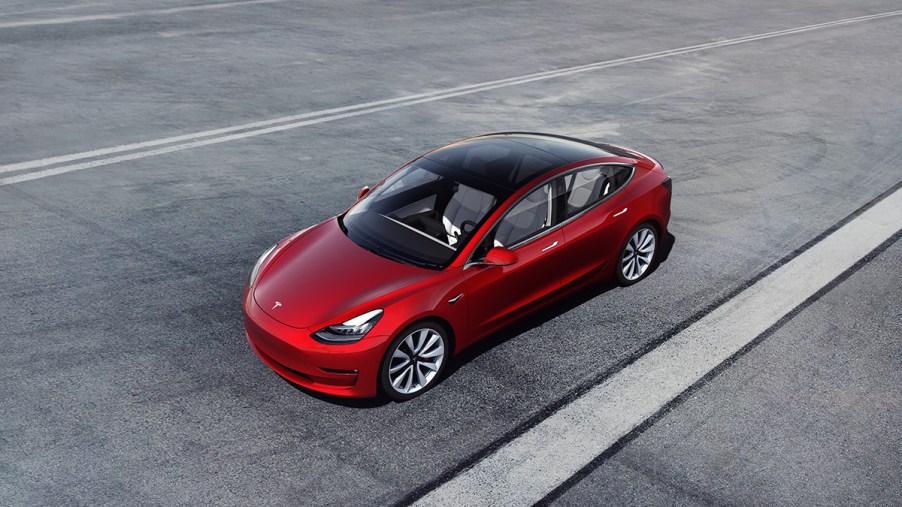
Tesla Model 3 vs Dodge Charger Hellcat: Which Is Faster?
Imagine you’re hanging out at your local drag strip. You watch the usual Mustangs, Camaros, and Challengers battle it out for domination of the quarter-mile stretch. But then the next two contenders rolling up are a Dodge Charger SRT Hellcat and a…Tesla Model 3 Performance?
Although the Model 3 has a great reputation on the track, it looks out of place among big beefy pony cars. And yet it’s held its own in sprints with vehicle class competitors such as the BMW M3, the Mercedes AMG C63S, and the Alfa Romeo, Giulia Quadrifoglio, among others. Still, can an EV—even a tuned Tesla—outrun the Charger, a brute so perfectly suited for drag racing? Before we reveal the winner, let’s look at each competitor’s specs.
Dodge Charger SRT Hellcat Specs
With its supercharged 6.2-liter Hemi V8, the Hellcat threatens to put any rival on the trailer. It pumps out 707 hp and 650 lb-ft of torque, and Dodge claims a top speed of 204 mph. This muscle car goes from zero to 60 in 3.4 seconds and can do a quarter-mile in 11.4 seconds. Its eight-speed automatic transmission and rear-wheel drive give it the power behind these impressive acceleration times.
Grippy Pirelli P Zero summer tires that wrap around 20-inch wheels provide the Hellcat with improved accelerating, braking, and cornering. Dual air inlets in the grille and a large air scoop and heat extractors on the hood feed oxygen to the gigantic engine. Brembo brakes give the Hellcat superior braking power.
A feature that gives the Hellcat an edge on the drag strip is its launch control, which helps the driver to accelerate quickly from a standing start. Dodge also has borrowed a couple of the superpowers from the outgoing Challenger SRT Demon to make the Hellcat even more straight-line-worthy. The after-run chiller sends coolant through the charger air cooler to decrease the temperature of the supercharger and, as a result, steps up horsepower. Its torque reserve is integrated with launch control to close the supercharger’s bypass valve in order to precharge it.
This Dodge’s curb weight of 4,575 pounds makes it a little too brawny for the track but ideal for the drag strip. And it’s still a five-seater sedan, so both you and your family can luxuriate in the Hellcat’s intimidating exhaust note as you hoon about town.
Tesla Model 3 Performance Specs
On paper, the Hellcat far outstrips the Model 3 in horsepower. The Tesla’s dual electric motors churn out 473 hp and 471 lb-ft of torque, which is still fast by most standards, though. It can blast from 0 to 60 in 3.3 seconds and does the quarter-mile in 11.8. It has a one-speed fixed transmission and all-wheel drive, and the latter is a great advantage for the car’s traction from a standing start.
The Model 3 Performance is equipped with sticky Michelin Pilot Sport 4S tires on 20-inch wheels. The Performance variant sits a bit lower than other Model 3s, and its brakes are larger, with 14-inch rotors and four-piston fixed calipers in front. The chunky 75 kWh battery pack under the floor of the vehicle stabilizes the car and gives it a lower center of gravity.
The curb weight for this car is 4,072 pounds, which is quite a bit lighter than the Hellcat. Like the Hellcat, the Model 3 is a four-door sedan. But if the family rides with you in the Model 3, all you’ll hear is the sound of the tires on the highway thanks to its quiet e-motors.
While this Model 3 was designed for performance with some quick track runs, it was never intended to be taken through the repeated quarter-mile cycles that a car like the Hellcat would experience. The Tesla Model 3 was built to be the Everyman’s EV. Even in the case of the Performance variant, most people initially didn’t expect it to perform as well as the Model S.
Drag Race
The moment of truth for these cars has arrived, thanks to the folks at InsideEVs. Which car is faster on the straight line, the muscle car or the EV? Is it better to be faster from 0 to 60 mph or from 100 to 200 mph? Check the video below to find out.


